ACCC0 Early Childhood Teacher Bridging Program: Cluster 1 Assignment
VerifiedAdded on 2023/01/17
|38
|10247
|37
Homework Assignment
AI Summary
This assignment solution addresses the requirements of ECTBP Cluster 1, focusing on wellbeing and safety in early childhood education and care. The assignment covers key units of competency, including ensuring children's health and safety, establishing a safe environment, maintaining work health and safety, and identifying and responding to children at risk. The introduction highlights the Early Childhood Teacher Bridging Program (ECTBP), designed for primary trained teachers seeking early childhood qualifications. The solution includes instructions for assessment tasks, emphasizing both theory and practice, and outlines the assessment process. It includes a scenario involving a sick baby and asks for steps to care for the baby, other children, families, and educators. The document references relevant texts and resources to support the understanding of the assignment and the subject matter.
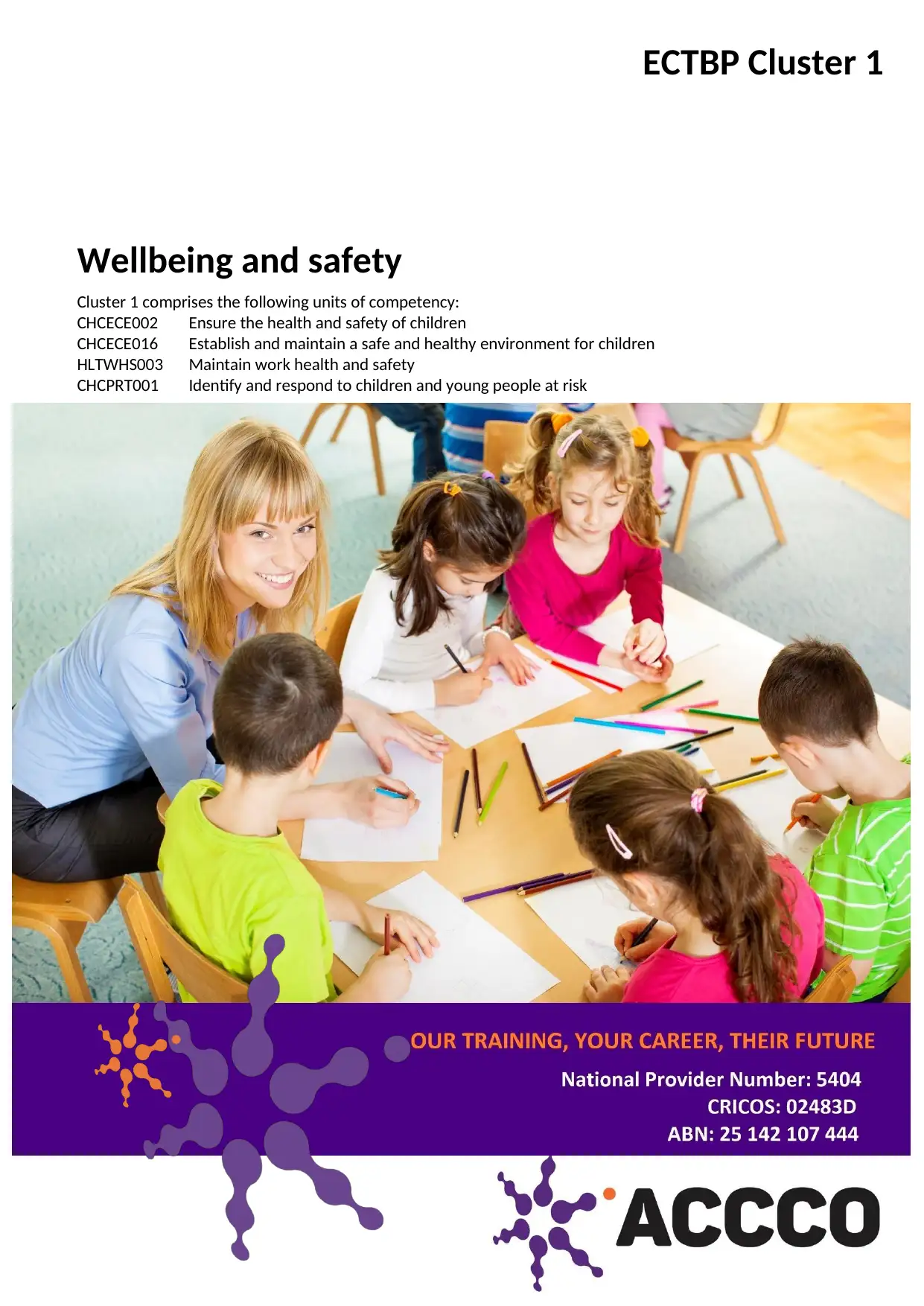
Wellbeing and safety
Cluster 1 comprises the following units of competency:
CHCECE002 Ensure the health and safety of children
CHCECE016 Establish and maintain a safe and healthy environment for children
HLTWHS003 Maintain work health and safety
CHCPRT001 Identify and respond to children and young people at risk
ECTBP Cluster 1
Cluster 1 comprises the following units of competency:
CHCECE002 Ensure the health and safety of children
CHCECE016 Establish and maintain a safe and healthy environment for children
HLTWHS003 Maintain work health and safety
CHCPRT001 Identify and respond to children and young people at risk
ECTBP Cluster 1
Paraphrase This Document
Need a fresh take? Get an instant paraphrase of this document with our AI Paraphraser
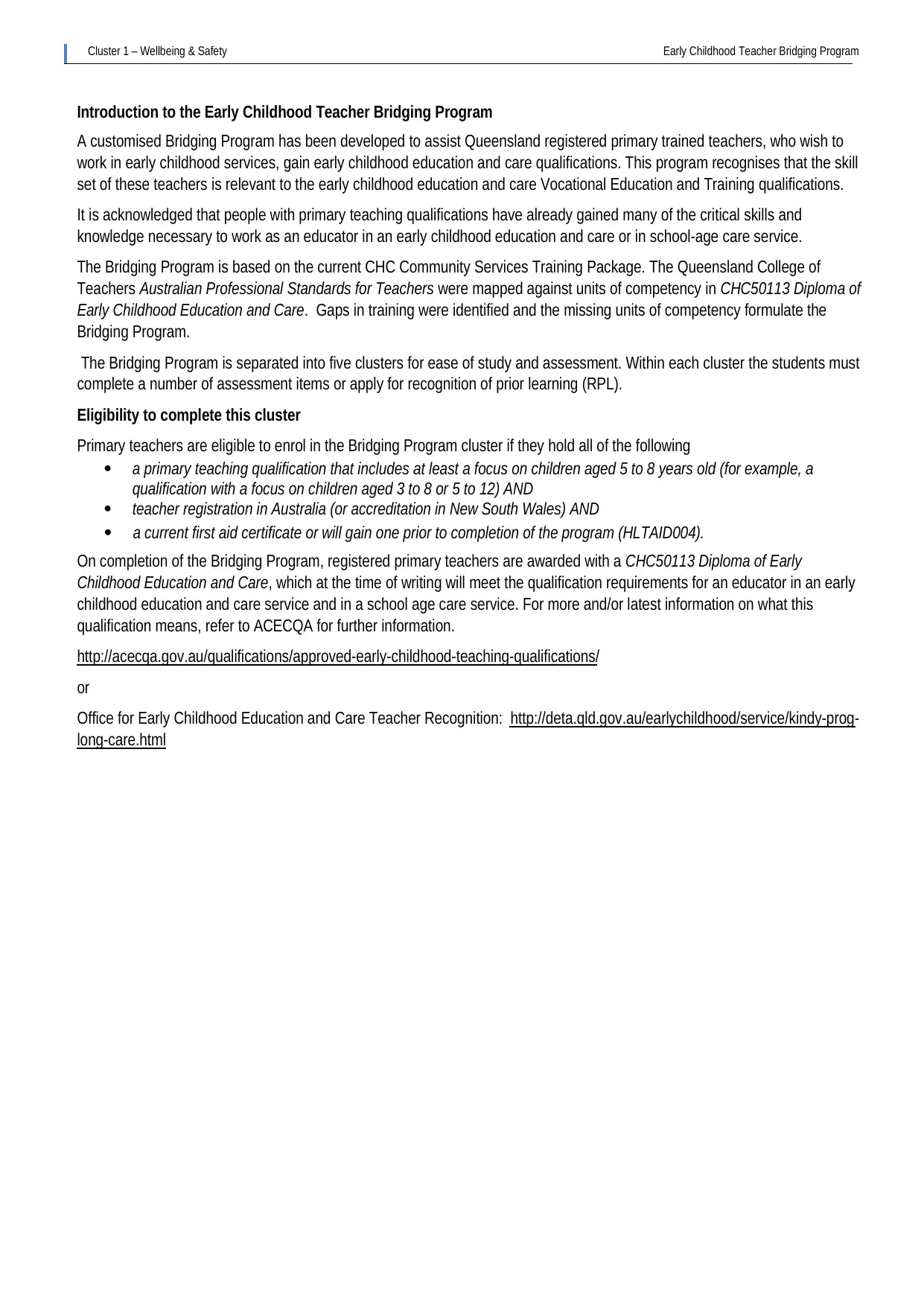
Cluster 1 – Wellbeing & Safety Early Childhood Teacher Bridging Program
Introduction to the Early Childhood Teacher Bridging Program
A customised Bridging Program has been developed to assist Queensland registered primary trained teachers, who wish to
work in early childhood services, gain early childhood education and care qualifications. This program recognises that the skill
set of these teachers is relevant to the early childhood education and care Vocational Education and Training qualifications.
It is acknowledged that people with primary teaching qualifications have already gained many of the critical skills and
knowledge necessary to work as an educator in an early childhood education and care or in school-age care service.
The Bridging Program is based on the current CHC Community Services Training Package. The Queensland College of
Teachers Australian Professional Standards for Teachers were mapped against units of competency in CHC50113 Diploma of
Early Childhood Education and Care. Gaps in training were identified and the missing units of competency formulate the
Bridging Program.
The Bridging Program is separated into five clusters for ease of study and assessment. Within each cluster the students must
complete a number of assessment items or apply for recognition of prior learning (RPL).
Eligibility to complete this cluster
Primary teachers are eligible to enrol in the Bridging Program cluster if they hold all of the following
a primary teaching qualification that includes at least a focus on children aged 5 to 8 years old (for example, a
qualification with a focus on children aged 3 to 8 or 5 to 12) AND
teacher registration in Australia (or accreditation in New South Wales) AND
a current first aid certificate or will gain one prior to completion of the program (HLTAID004).
On completion of the Bridging Program, registered primary teachers are awarded with a CHC50113 Diploma of Early
Childhood Education and Care, which at the time of writing will meet the qualification requirements for an educator in an early
childhood education and care service and in a school age care service. For more and/or latest information on what this
qualification means, refer to ACECQA for further information.
http://acecqa.gov.au/qualifications/approved-early-childhood-teaching-qualifications/
or
Office for Early Childhood Education and Care Teacher Recognition: http://deta.qld.gov.au/earlychildhood/service/kindy-prog-
long-care.html
Introduction to the Early Childhood Teacher Bridging Program
A customised Bridging Program has been developed to assist Queensland registered primary trained teachers, who wish to
work in early childhood services, gain early childhood education and care qualifications. This program recognises that the skill
set of these teachers is relevant to the early childhood education and care Vocational Education and Training qualifications.
It is acknowledged that people with primary teaching qualifications have already gained many of the critical skills and
knowledge necessary to work as an educator in an early childhood education and care or in school-age care service.
The Bridging Program is based on the current CHC Community Services Training Package. The Queensland College of
Teachers Australian Professional Standards for Teachers were mapped against units of competency in CHC50113 Diploma of
Early Childhood Education and Care. Gaps in training were identified and the missing units of competency formulate the
Bridging Program.
The Bridging Program is separated into five clusters for ease of study and assessment. Within each cluster the students must
complete a number of assessment items or apply for recognition of prior learning (RPL).
Eligibility to complete this cluster
Primary teachers are eligible to enrol in the Bridging Program cluster if they hold all of the following
a primary teaching qualification that includes at least a focus on children aged 5 to 8 years old (for example, a
qualification with a focus on children aged 3 to 8 or 5 to 12) AND
teacher registration in Australia (or accreditation in New South Wales) AND
a current first aid certificate or will gain one prior to completion of the program (HLTAID004).
On completion of the Bridging Program, registered primary teachers are awarded with a CHC50113 Diploma of Early
Childhood Education and Care, which at the time of writing will meet the qualification requirements for an educator in an early
childhood education and care service and in a school age care service. For more and/or latest information on what this
qualification means, refer to ACECQA for further information.
http://acecqa.gov.au/qualifications/approved-early-childhood-teaching-qualifications/
or
Office for Early Childhood Education and Care Teacher Recognition: http://deta.qld.gov.au/earlychildhood/service/kindy-prog-
long-care.html
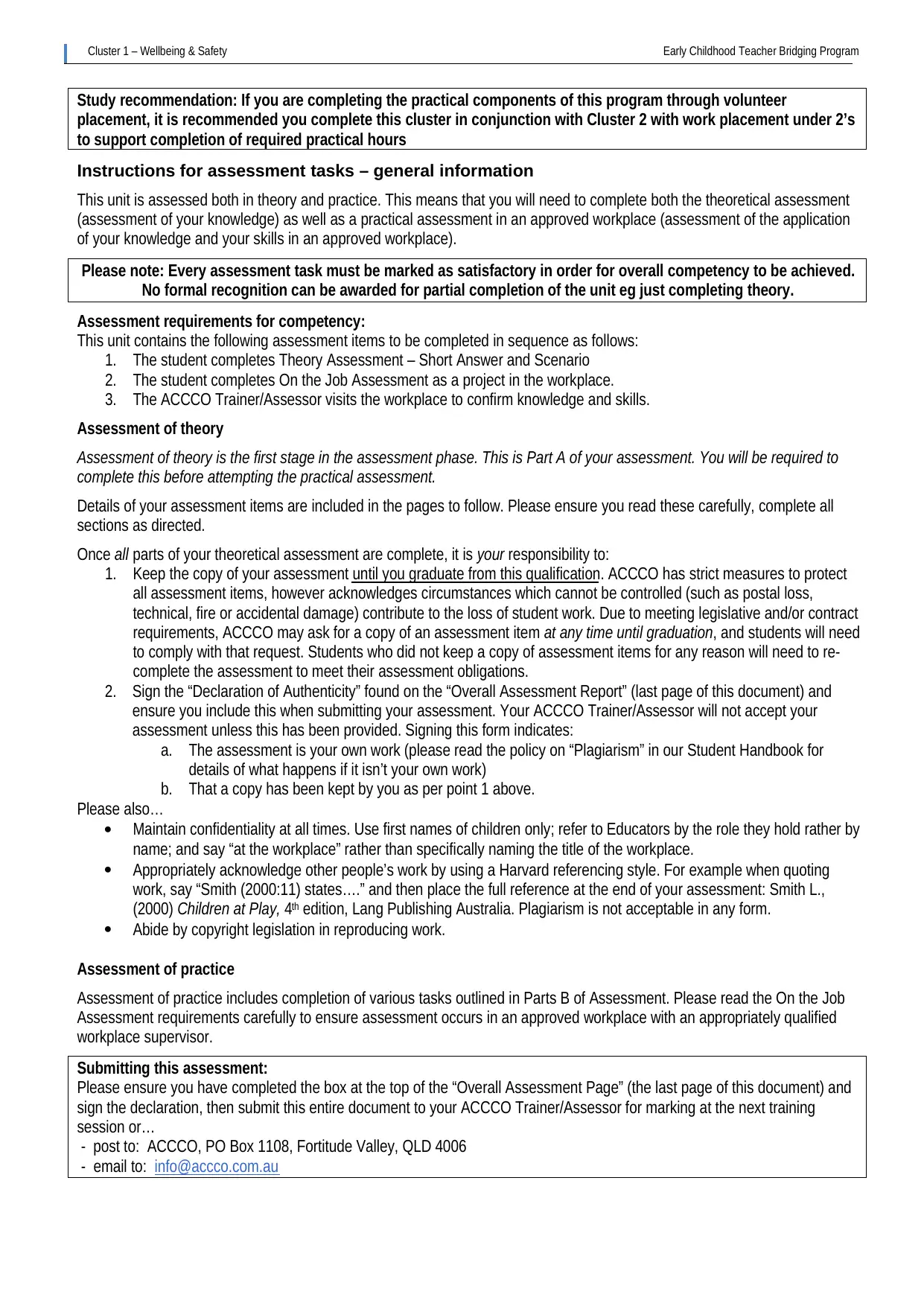
Cluster 1 – Wellbeing & Safety Early Childhood Teacher Bridging Program
Study recommendation: If you are completing the practical components of this program through volunteer
placement, it is recommended you complete this cluster in conjunction with Cluster 2 with work placement under 2’s
to support completion of required practical hours
Instructions for assessment tasks – general information
This unit is assessed both in theory and practice. This means that you will need to complete both the theoretical assessment
(assessment of your knowledge) as well as a practical assessment in an approved workplace (assessment of the application
of your knowledge and your skills in an approved workplace).
Please note: Every assessment task must be marked as satisfactory in order for overall competency to be achieved.
No formal recognition can be awarded for partial completion of the unit eg just completing theory.
Assessment requirements for competency:
This unit contains the following assessment items to be completed in sequence as follows:
1. The student completes Theory Assessment – Short Answer and Scenario
2. The student completes On the Job Assessment as a project in the workplace.
3. The ACCCO Trainer/Assessor visits the workplace to confirm knowledge and skills.
Assessment of theory
Assessment of theory is the first stage in the assessment phase. This is Part A of your assessment. You will be required to
complete this before attempting the practical assessment.
Details of your assessment items are included in the pages to follow. Please ensure you read these carefully, complete all
sections as directed.
Once all parts of your theoretical assessment are complete, it is your responsibility to:
1. Keep the copy of your assessment until you graduate from this qualification. ACCCO has strict measures to protect
all assessment items, however acknowledges circumstances which cannot be controlled (such as postal loss,
technical, fire or accidental damage) contribute to the loss of student work. Due to meeting legislative and/or contract
requirements, ACCCO may ask for a copy of an assessment item at any time until graduation, and students will need
to comply with that request. Students who did not keep a copy of assessment items for any reason will need to re-
complete the assessment to meet their assessment obligations.
2. Sign the “Declaration of Authenticity” found on the “Overall Assessment Report” (last page of this document) and
ensure you include this when submitting your assessment. Your ACCCO Trainer/Assessor will not accept your
assessment unless this has been provided. Signing this form indicates:
a. The assessment is your own work (please read the policy on “Plagiarism” in our Student Handbook for
details of what happens if it isn’t your own work)
b. That a copy has been kept by you as per point 1 above.
Please also…
Maintain confidentiality at all times. Use first names of children only; refer to Educators by the role they hold rather by
name; and say “at the workplace” rather than specifically naming the title of the workplace.
Appropriately acknowledge other people’s work by using a Harvard referencing style. For example when quoting
work, say “Smith (2000:11) states….” and then place the full reference at the end of your assessment: Smith L.,
(2000) Children at Play, 4th edition, Lang Publishing Australia. Plagiarism is not acceptable in any form.
Abide by copyright legislation in reproducing work.
Assessment of practice
Assessment of practice includes completion of various tasks outlined in Parts B of Assessment. Please read the On the Job
Assessment requirements carefully to ensure assessment occurs in an approved workplace with an appropriately qualified
workplace supervisor.
Submitting this assessment:
Please ensure you have completed the box at the top of the “Overall Assessment Page” (the last page of this document) and
sign the declaration, then submit this entire document to your ACCCO Trainer/Assessor for marking at the next training
session or…
- post to: ACCCO, PO Box 1108, Fortitude Valley, QLD 4006
- email to: info@accco.com.au
Study recommendation: If you are completing the practical components of this program through volunteer
placement, it is recommended you complete this cluster in conjunction with Cluster 2 with work placement under 2’s
to support completion of required practical hours
Instructions for assessment tasks – general information
This unit is assessed both in theory and practice. This means that you will need to complete both the theoretical assessment
(assessment of your knowledge) as well as a practical assessment in an approved workplace (assessment of the application
of your knowledge and your skills in an approved workplace).
Please note: Every assessment task must be marked as satisfactory in order for overall competency to be achieved.
No formal recognition can be awarded for partial completion of the unit eg just completing theory.
Assessment requirements for competency:
This unit contains the following assessment items to be completed in sequence as follows:
1. The student completes Theory Assessment – Short Answer and Scenario
2. The student completes On the Job Assessment as a project in the workplace.
3. The ACCCO Trainer/Assessor visits the workplace to confirm knowledge and skills.
Assessment of theory
Assessment of theory is the first stage in the assessment phase. This is Part A of your assessment. You will be required to
complete this before attempting the practical assessment.
Details of your assessment items are included in the pages to follow. Please ensure you read these carefully, complete all
sections as directed.
Once all parts of your theoretical assessment are complete, it is your responsibility to:
1. Keep the copy of your assessment until you graduate from this qualification. ACCCO has strict measures to protect
all assessment items, however acknowledges circumstances which cannot be controlled (such as postal loss,
technical, fire or accidental damage) contribute to the loss of student work. Due to meeting legislative and/or contract
requirements, ACCCO may ask for a copy of an assessment item at any time until graduation, and students will need
to comply with that request. Students who did not keep a copy of assessment items for any reason will need to re-
complete the assessment to meet their assessment obligations.
2. Sign the “Declaration of Authenticity” found on the “Overall Assessment Report” (last page of this document) and
ensure you include this when submitting your assessment. Your ACCCO Trainer/Assessor will not accept your
assessment unless this has been provided. Signing this form indicates:
a. The assessment is your own work (please read the policy on “Plagiarism” in our Student Handbook for
details of what happens if it isn’t your own work)
b. That a copy has been kept by you as per point 1 above.
Please also…
Maintain confidentiality at all times. Use first names of children only; refer to Educators by the role they hold rather by
name; and say “at the workplace” rather than specifically naming the title of the workplace.
Appropriately acknowledge other people’s work by using a Harvard referencing style. For example when quoting
work, say “Smith (2000:11) states….” and then place the full reference at the end of your assessment: Smith L.,
(2000) Children at Play, 4th edition, Lang Publishing Australia. Plagiarism is not acceptable in any form.
Abide by copyright legislation in reproducing work.
Assessment of practice
Assessment of practice includes completion of various tasks outlined in Parts B of Assessment. Please read the On the Job
Assessment requirements carefully to ensure assessment occurs in an approved workplace with an appropriately qualified
workplace supervisor.
Submitting this assessment:
Please ensure you have completed the box at the top of the “Overall Assessment Page” (the last page of this document) and
sign the declaration, then submit this entire document to your ACCCO Trainer/Assessor for marking at the next training
session or…
- post to: ACCCO, PO Box 1108, Fortitude Valley, QLD 4006
- email to: info@accco.com.au
⊘ This is a preview!⊘
Do you want full access?
Subscribe today to unlock all pages.

Trusted by 1+ million students worldwide
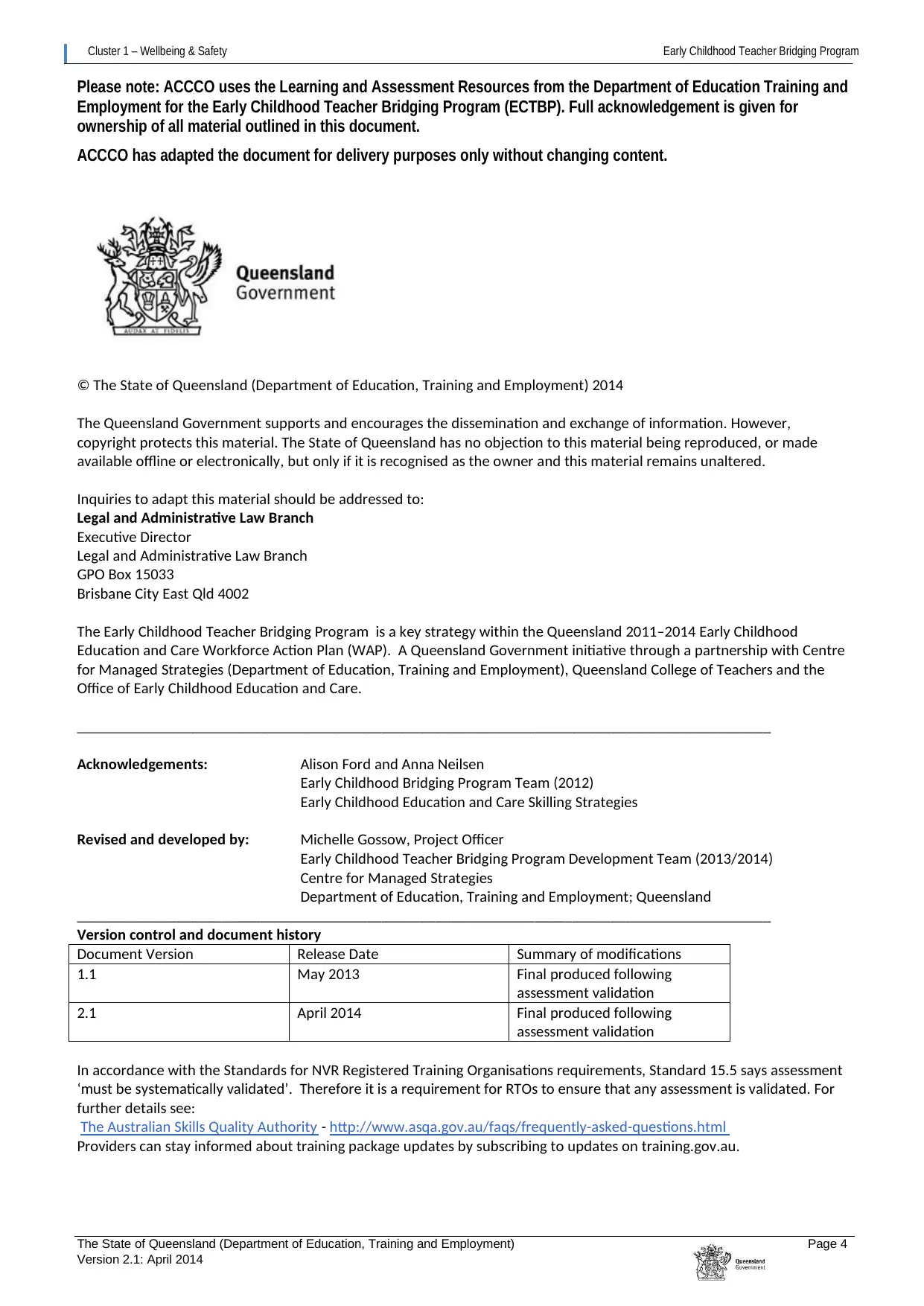
Cluster 1 – Wellbeing & Safety Early Childhood Teacher Bridging Program
The State of Queensland (Department of Education, Training and Employment) Page 4
Version 2.1: April 2014
Please note: ACCCO uses the Learning and Assessment Resources from the Department of Education Training and
Employment for the Early Childhood Teacher Bridging Program (ECTBP). Full acknowledgement is given for
ownership of all material outlined in this document.
ACCCO has adapted the document for delivery purposes only without changing content.
© The State of Queensland (Department of Education, Training and Employment) 2014
The Queensland Government supports and encourages the dissemination and exchange of information. However,
copyright protects this material. The State of Queensland has no objection to this material being reproduced, or made
available offline or electronically, but only if it is recognised as the owner and this material remains unaltered.
Inquiries to adapt this material should be addressed to:
Legal and Administrative Law Branch
Executive Director
Legal and Administrative Law Branch
GPO Box 15033
Brisbane City East Qld 4002
The Early Childhood Teacher Bridging Program is a key strategy within the Queensland 2011–2014 Early Childhood
Education and Care Workforce Action Plan (WAP). A Queensland Government initiative through a partnership with Centre
for Managed Strategies (Department of Education, Training and Employment), Queensland College of Teachers and the
Office of Early Childhood Education and Care.
___________________________________________________________________________________________
Acknowledgements: Alison Ford and Anna Neilsen
Early Childhood Bridging Program Team (2012)
Early Childhood Education and Care Skilling Strategies
Revised and developed by: Michelle Gossow, Project Officer
Early Childhood Teacher Bridging Program Development Team (2013/2014)
Centre for Managed Strategies
Department of Education, Training and Employment; Queensland
___________________________________________________________________________________________
Version control and document history
Document Version Release Date Summary of modifications
1.1 May 2013 Final produced following
assessment validation
2.1 April 2014 Final produced following
assessment validation
In accordance with the Standards for NVR Registered Training Organisations requirements, Standard 15.5 says assessment
‘must be systematically validated’. Therefore it is a requirement for RTOs to ensure that any assessment is validated. For
further details see:
The Australian Skills Quality Authority - http://www.asqa.gov.au/faqs/frequently-asked-questions.html
Providers can stay informed about training package updates by subscribing to updates on training.gov.au.
The State of Queensland (Department of Education, Training and Employment) Page 4
Version 2.1: April 2014
Please note: ACCCO uses the Learning and Assessment Resources from the Department of Education Training and
Employment for the Early Childhood Teacher Bridging Program (ECTBP). Full acknowledgement is given for
ownership of all material outlined in this document.
ACCCO has adapted the document for delivery purposes only without changing content.
© The State of Queensland (Department of Education, Training and Employment) 2014
The Queensland Government supports and encourages the dissemination and exchange of information. However,
copyright protects this material. The State of Queensland has no objection to this material being reproduced, or made
available offline or electronically, but only if it is recognised as the owner and this material remains unaltered.
Inquiries to adapt this material should be addressed to:
Legal and Administrative Law Branch
Executive Director
Legal and Administrative Law Branch
GPO Box 15033
Brisbane City East Qld 4002
The Early Childhood Teacher Bridging Program is a key strategy within the Queensland 2011–2014 Early Childhood
Education and Care Workforce Action Plan (WAP). A Queensland Government initiative through a partnership with Centre
for Managed Strategies (Department of Education, Training and Employment), Queensland College of Teachers and the
Office of Early Childhood Education and Care.
___________________________________________________________________________________________
Acknowledgements: Alison Ford and Anna Neilsen
Early Childhood Bridging Program Team (2012)
Early Childhood Education and Care Skilling Strategies
Revised and developed by: Michelle Gossow, Project Officer
Early Childhood Teacher Bridging Program Development Team (2013/2014)
Centre for Managed Strategies
Department of Education, Training and Employment; Queensland
___________________________________________________________________________________________
Version control and document history
Document Version Release Date Summary of modifications
1.1 May 2013 Final produced following
assessment validation
2.1 April 2014 Final produced following
assessment validation
In accordance with the Standards for NVR Registered Training Organisations requirements, Standard 15.5 says assessment
‘must be systematically validated’. Therefore it is a requirement for RTOs to ensure that any assessment is validated. For
further details see:
The Australian Skills Quality Authority - http://www.asqa.gov.au/faqs/frequently-asked-questions.html
Providers can stay informed about training package updates by subscribing to updates on training.gov.au.
Paraphrase This Document
Need a fresh take? Get an instant paraphrase of this document with our AI Paraphraser
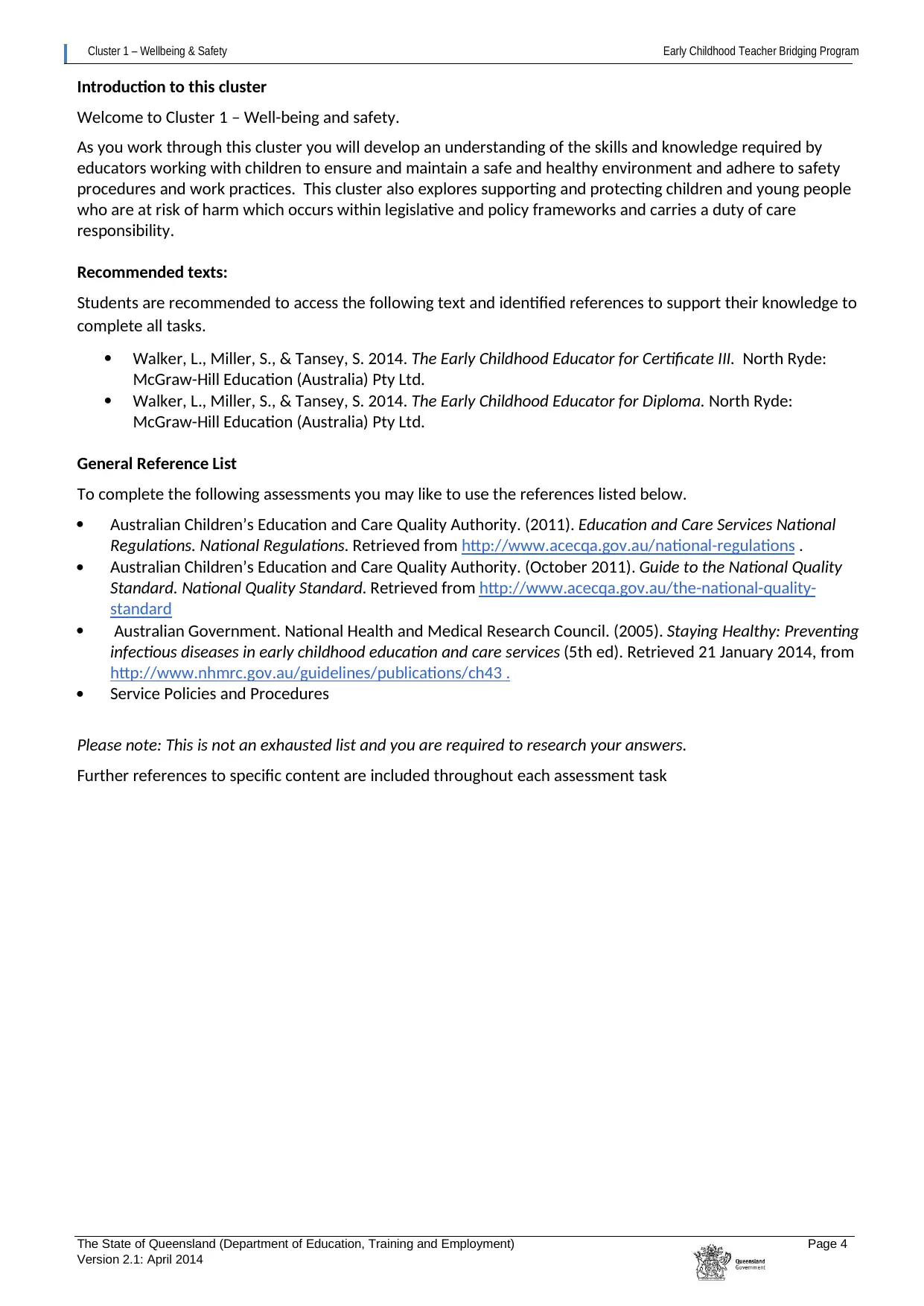
Cluster 1 – Wellbeing & Safety Early Childhood Teacher Bridging Program
The State of Queensland (Department of Education, Training and Employment) Page 4
Version 2.1: April 2014
Introduction to this cluster
Welcome to Cluster 1 – Well-being and safety.
As you work through this cluster you will develop an understanding of the skills and knowledge required by
educators working with children to ensure and maintain a safe and healthy environment and adhere to safety
procedures and work practices. This cluster also explores supporting and protecting children and young people
who are at risk of harm which occurs within legislative and policy frameworks and carries a duty of care
responsibility.
Recommended texts:
Students are recommended to access the following text and identified references to support their knowledge to
complete all tasks.
Walker, L., Miller, S., & Tansey, S. 2014. The Early Childhood Educator for Certificate III. North Ryde:
McGraw-Hill Education (Australia) Pty Ltd.
Walker, L., Miller, S., & Tansey, S. 2014. The Early Childhood Educator for Diploma. North Ryde:
McGraw-Hill Education (Australia) Pty Ltd.
General Reference List
To complete the following assessments you may like to use the references listed below.
Australian Children’s Education and Care Quality Authority. (2011). Education and Care Services National
Regulations. National Regulations. Retrieved from http://www.acecqa.gov.au/national-regulations .
Australian Children’s Education and Care Quality Authority. (October 2011). Guide to the National Quality
Standard. National Quality Standard. Retrieved from http://www.acecqa.gov.au/the-national-quality-
standard
Australian Government. National Health and Medical Research Council. (2005). Staying Healthy: Preventing
infectious diseases in early childhood education and care services (5th ed). Retrieved 21 January 2014, from
http://www.nhmrc.gov.au/guidelines/publications/ch43 .
Service Policies and Procedures
Please note: This is not an exhausted list and you are required to research your answers.
Further references to specific content are included throughout each assessment task
The State of Queensland (Department of Education, Training and Employment) Page 4
Version 2.1: April 2014
Introduction to this cluster
Welcome to Cluster 1 – Well-being and safety.
As you work through this cluster you will develop an understanding of the skills and knowledge required by
educators working with children to ensure and maintain a safe and healthy environment and adhere to safety
procedures and work practices. This cluster also explores supporting and protecting children and young people
who are at risk of harm which occurs within legislative and policy frameworks and carries a duty of care
responsibility.
Recommended texts:
Students are recommended to access the following text and identified references to support their knowledge to
complete all tasks.
Walker, L., Miller, S., & Tansey, S. 2014. The Early Childhood Educator for Certificate III. North Ryde:
McGraw-Hill Education (Australia) Pty Ltd.
Walker, L., Miller, S., & Tansey, S. 2014. The Early Childhood Educator for Diploma. North Ryde:
McGraw-Hill Education (Australia) Pty Ltd.
General Reference List
To complete the following assessments you may like to use the references listed below.
Australian Children’s Education and Care Quality Authority. (2011). Education and Care Services National
Regulations. National Regulations. Retrieved from http://www.acecqa.gov.au/national-regulations .
Australian Children’s Education and Care Quality Authority. (October 2011). Guide to the National Quality
Standard. National Quality Standard. Retrieved from http://www.acecqa.gov.au/the-national-quality-
standard
Australian Government. National Health and Medical Research Council. (2005). Staying Healthy: Preventing
infectious diseases in early childhood education and care services (5th ed). Retrieved 21 January 2014, from
http://www.nhmrc.gov.au/guidelines/publications/ch43 .
Service Policies and Procedures
Please note: This is not an exhausted list and you are required to research your answers.
Further references to specific content are included throughout each assessment task
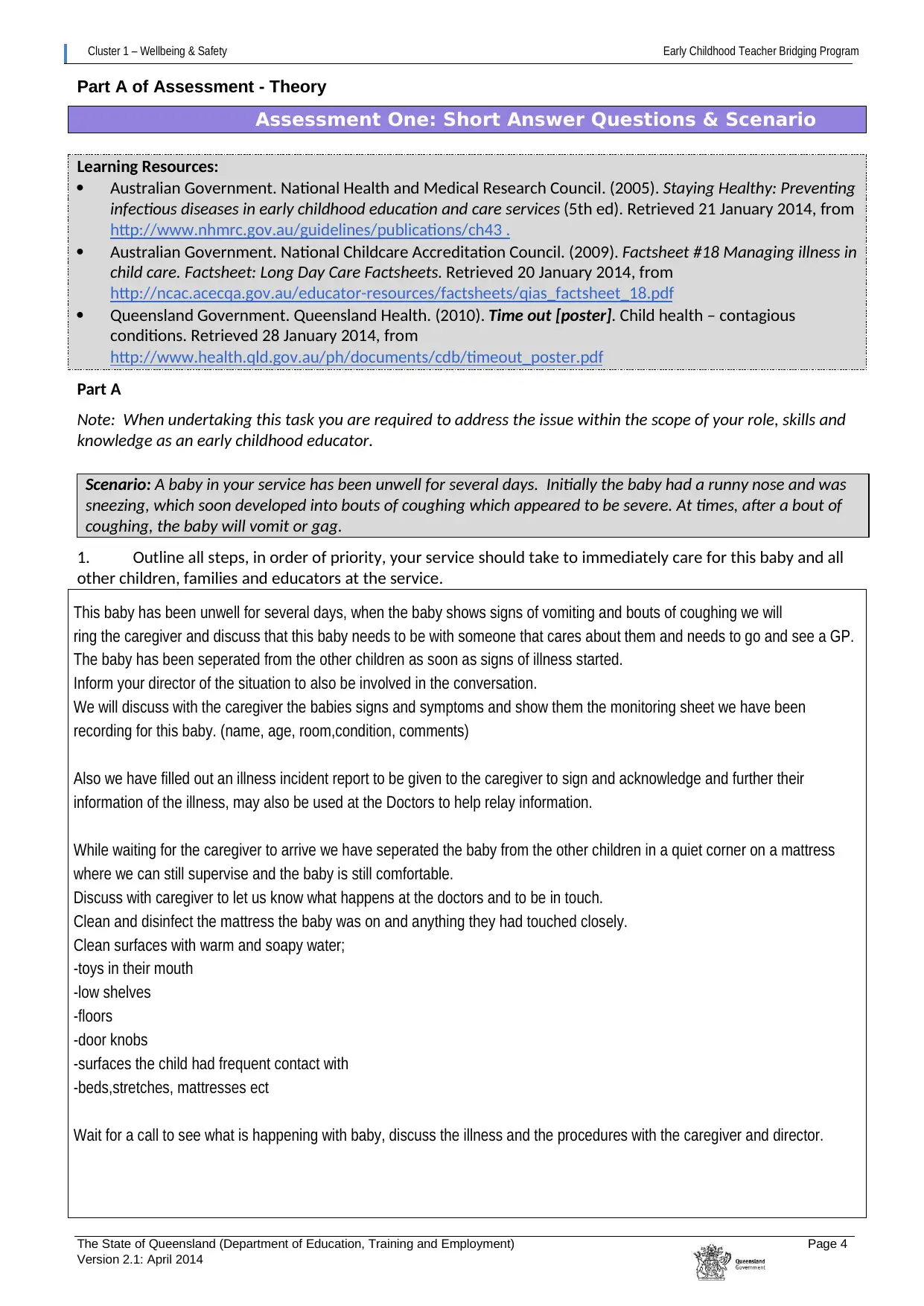
Cluster 1 – Wellbeing & Safety Early Childhood Teacher Bridging Program
The State of Queensland (Department of Education, Training and Employment) Page 4
Version 2.1: April 2014
Part A of Assessment - Theory
Assessment One: Short Answer Questions & Scenario
Learning Resources:
Australian Government. National Health and Medical Research Council. (2005). Staying Healthy: Preventing
infectious diseases in early childhood education and care services (5th ed). Retrieved 21 January 2014, from
http://www.nhmrc.gov.au/guidelines/publications/ch43 .
Australian Government. National Childcare Accreditation Council. (2009). Factsheet #18 Managing illness in
child care. Factsheet: Long Day Care Factsheets. Retrieved 20 January 2014, from
http://ncac.acecqa.gov.au/educator-resources/factsheets/qias_factsheet_18.pdf
Queensland Government. Queensland Health. (2010). Time out [poster]. Child health – contagious
conditions. Retrieved 28 January 2014, from
http://www.health.qld.gov.au/ph/documents/cdb/timeout_poster.pdf
Part A
Note: When undertaking this task you are required to address the issue within the scope of your role, skills and
knowledge as an early childhood educator.
Scenario: A baby in your service has been unwell for several days. Initially the baby had a runny nose and was
sneezing, which soon developed into bouts of coughing which appeared to be severe. At times, after a bout of
coughing, the baby will vomit or gag.
1. Outline all steps, in order of priority, your service should take to immediately care for this baby and all
other children, families and educators at the service.
This baby has been unwell for several days, when the baby shows signs of vomiting and bouts of coughing we will
ring the caregiver and discuss that this baby needs to be with someone that cares about them and needs to go and see a GP.
The baby has been seperated from the other children as soon as signs of illness started.
Inform your director of the situation to also be involved in the conversation.
We will discuss with the caregiver the babies signs and symptoms and show them the monitoring sheet we have been
recording for this baby. (name, age, room,condition, comments)
Also we have filled out an illness incident report to be given to the caregiver to sign and acknowledge and further their
information of the illness, may also be used at the Doctors to help relay information.
While waiting for the caregiver to arrive we have seperated the baby from the other children in a quiet corner on a mattress
where we can still supervise and the baby is still comfortable.
Discuss with caregiver to let us know what happens at the doctors and to be in touch.
Clean and disinfect the mattress the baby was on and anything they had touched closely.
Clean surfaces with warm and soapy water;
-toys in their mouth
-low shelves
-floors
-door knobs
-surfaces the child had frequent contact with
-beds,stretches, mattresses ect
Wait for a call to see what is happening with baby, discuss the illness and the procedures with the caregiver and director.
The State of Queensland (Department of Education, Training and Employment) Page 4
Version 2.1: April 2014
Part A of Assessment - Theory
Assessment One: Short Answer Questions & Scenario
Learning Resources:
Australian Government. National Health and Medical Research Council. (2005). Staying Healthy: Preventing
infectious diseases in early childhood education and care services (5th ed). Retrieved 21 January 2014, from
http://www.nhmrc.gov.au/guidelines/publications/ch43 .
Australian Government. National Childcare Accreditation Council. (2009). Factsheet #18 Managing illness in
child care. Factsheet: Long Day Care Factsheets. Retrieved 20 January 2014, from
http://ncac.acecqa.gov.au/educator-resources/factsheets/qias_factsheet_18.pdf
Queensland Government. Queensland Health. (2010). Time out [poster]. Child health – contagious
conditions. Retrieved 28 January 2014, from
http://www.health.qld.gov.au/ph/documents/cdb/timeout_poster.pdf
Part A
Note: When undertaking this task you are required to address the issue within the scope of your role, skills and
knowledge as an early childhood educator.
Scenario: A baby in your service has been unwell for several days. Initially the baby had a runny nose and was
sneezing, which soon developed into bouts of coughing which appeared to be severe. At times, after a bout of
coughing, the baby will vomit or gag.
1. Outline all steps, in order of priority, your service should take to immediately care for this baby and all
other children, families and educators at the service.
This baby has been unwell for several days, when the baby shows signs of vomiting and bouts of coughing we will
ring the caregiver and discuss that this baby needs to be with someone that cares about them and needs to go and see a GP.
The baby has been seperated from the other children as soon as signs of illness started.
Inform your director of the situation to also be involved in the conversation.
We will discuss with the caregiver the babies signs and symptoms and show them the monitoring sheet we have been
recording for this baby. (name, age, room,condition, comments)
Also we have filled out an illness incident report to be given to the caregiver to sign and acknowledge and further their
information of the illness, may also be used at the Doctors to help relay information.
While waiting for the caregiver to arrive we have seperated the baby from the other children in a quiet corner on a mattress
where we can still supervise and the baby is still comfortable.
Discuss with caregiver to let us know what happens at the doctors and to be in touch.
Clean and disinfect the mattress the baby was on and anything they had touched closely.
Clean surfaces with warm and soapy water;
-toys in their mouth
-low shelves
-floors
-door knobs
-surfaces the child had frequent contact with
-beds,stretches, mattresses ect
Wait for a call to see what is happening with baby, discuss the illness and the procedures with the caregiver and director.
⊘ This is a preview!⊘
Do you want full access?
Subscribe today to unlock all pages.

Trusted by 1+ million students worldwide
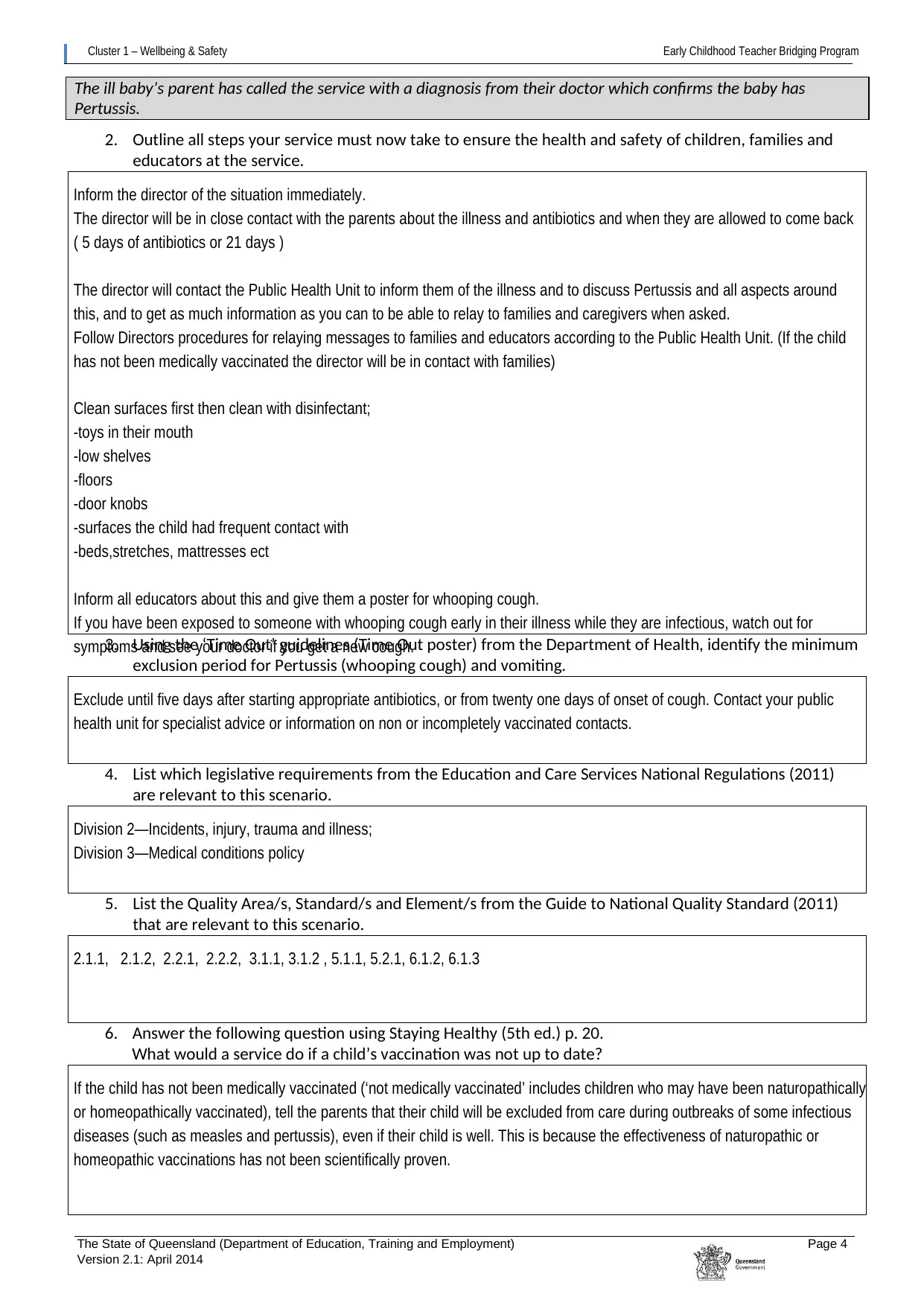
Cluster 1 – Wellbeing & Safety Early Childhood Teacher Bridging Program
The State of Queensland (Department of Education, Training and Employment) Page 4
Version 2.1: April 2014
The ill baby’s parent has called the service with a diagnosis from their doctor which confirms the baby has
Pertussis.
2. Outline all steps your service must now take to ensure the health and safety of children, families and
educators at the service.
3. Using the ‘Time Out’ guidelines (Time Out poster) from the Department of Health, identify the minimum
exclusion period for Pertussis (whooping cough) and vomiting.
4. List which legislative requirements from the Education and Care Services National Regulations (2011)
are relevant to this scenario.
5. List the Quality Area/s, Standard/s and Element/s from the Guide to National Quality Standard (2011)
that are relevant to this scenario.
6. Answer the following question using Staying Healthy (5th ed.) p. 20.
What would a service do if a child’s vaccination was not up to date?
Inform the director of the situation immediately.
The director will be in close contact with the parents about the illness and antibiotics and when they are allowed to come back
( 5 days of antibiotics or 21 days )
The director will contact the Public Health Unit to inform them of the illness and to discuss Pertussis and all aspects around
this, and to get as much information as you can to be able to relay to families and caregivers when asked.
Follow Directors procedures for relaying messages to families and educators according to the Public Health Unit. (If the child
has not been medically vaccinated the director will be in contact with families)
Clean surfaces first then clean with disinfectant;
-toys in their mouth
-low shelves
-floors
-door knobs
-surfaces the child had frequent contact with
-beds,stretches, mattresses ect
Inform all educators about this and give them a poster for whooping cough.
If you have been exposed to someone with whooping cough early in their illness while they are infectious, watch out for
symptoms and see your doctor if you get a new cough.
Exclude until five days after starting appropriate antibiotics, or from twenty one days of onset of cough. Contact your public
health unit for specialist advice or information on non or incompletely vaccinated contacts.
Division 2—Incidents, injury, trauma and illness;
Division 3—Medical conditions policy
2.1.1, 2.1.2, 2.2.1, 2.2.2, 3.1.1, 3.1.2 , 5.1.1, 5.2.1, 6.1.2, 6.1.3
If the child has not been medically vaccinated (‘not medically vaccinated’ includes children who may have been naturopathically
or homeopathically vaccinated), tell the parents that their child will be excluded from care during outbreaks of some infectious
diseases (such as measles and pertussis), even if their child is well. This is because the effectiveness of naturopathic or
homeopathic vaccinations has not been scientifically proven.
The State of Queensland (Department of Education, Training and Employment) Page 4
Version 2.1: April 2014
The ill baby’s parent has called the service with a diagnosis from their doctor which confirms the baby has
Pertussis.
2. Outline all steps your service must now take to ensure the health and safety of children, families and
educators at the service.
3. Using the ‘Time Out’ guidelines (Time Out poster) from the Department of Health, identify the minimum
exclusion period for Pertussis (whooping cough) and vomiting.
4. List which legislative requirements from the Education and Care Services National Regulations (2011)
are relevant to this scenario.
5. List the Quality Area/s, Standard/s and Element/s from the Guide to National Quality Standard (2011)
that are relevant to this scenario.
6. Answer the following question using Staying Healthy (5th ed.) p. 20.
What would a service do if a child’s vaccination was not up to date?
Inform the director of the situation immediately.
The director will be in close contact with the parents about the illness and antibiotics and when they are allowed to come back
( 5 days of antibiotics or 21 days )
The director will contact the Public Health Unit to inform them of the illness and to discuss Pertussis and all aspects around
this, and to get as much information as you can to be able to relay to families and caregivers when asked.
Follow Directors procedures for relaying messages to families and educators according to the Public Health Unit. (If the child
has not been medically vaccinated the director will be in contact with families)
Clean surfaces first then clean with disinfectant;
-toys in their mouth
-low shelves
-floors
-door knobs
-surfaces the child had frequent contact with
-beds,stretches, mattresses ect
Inform all educators about this and give them a poster for whooping cough.
If you have been exposed to someone with whooping cough early in their illness while they are infectious, watch out for
symptoms and see your doctor if you get a new cough.
Exclude until five days after starting appropriate antibiotics, or from twenty one days of onset of cough. Contact your public
health unit for specialist advice or information on non or incompletely vaccinated contacts.
Division 2—Incidents, injury, trauma and illness;
Division 3—Medical conditions policy
2.1.1, 2.1.2, 2.2.1, 2.2.2, 3.1.1, 3.1.2 , 5.1.1, 5.2.1, 6.1.2, 6.1.3
If the child has not been medically vaccinated (‘not medically vaccinated’ includes children who may have been naturopathically
or homeopathically vaccinated), tell the parents that their child will be excluded from care during outbreaks of some infectious
diseases (such as measles and pertussis), even if their child is well. This is because the effectiveness of naturopathic or
homeopathic vaccinations has not been scientifically proven.
Paraphrase This Document
Need a fresh take? Get an instant paraphrase of this document with our AI Paraphraser
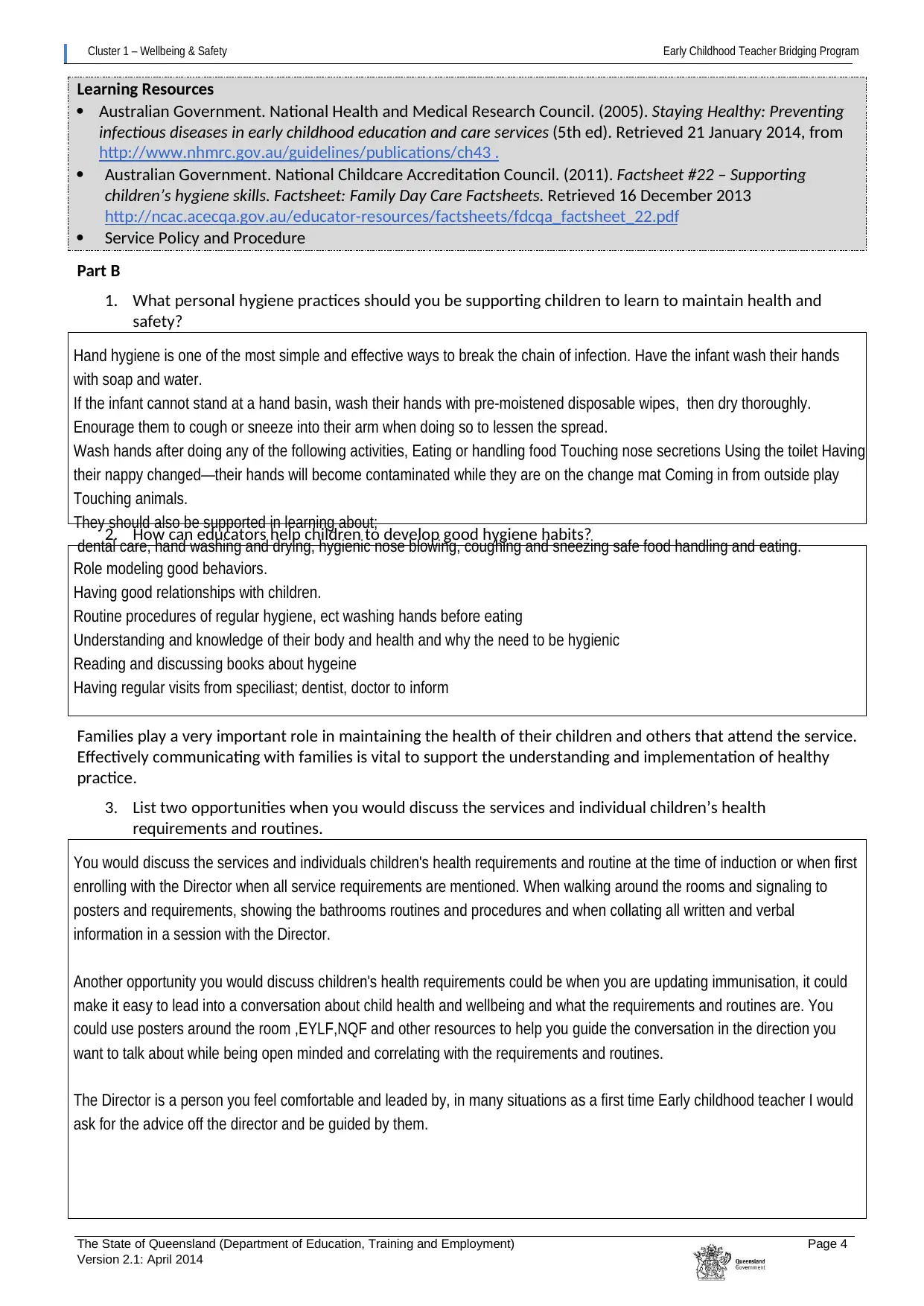
Cluster 1 – Wellbeing & Safety Early Childhood Teacher Bridging Program
The State of Queensland (Department of Education, Training and Employment) Page 4
Version 2.1: April 2014
Learning Resources
Australian Government. National Health and Medical Research Council. (2005). Staying Healthy: Preventing
infectious diseases in early childhood education and care services (5th ed). Retrieved 21 January 2014, from
http://www.nhmrc.gov.au/guidelines/publications/ch43 .
Australian Government. National Childcare Accreditation Council. (2011). Factsheet #22 – Supporting
children’s hygiene skills. Factsheet: Family Day Care Factsheets. Retrieved 16 December 2013
http://ncac.acecqa.gov.au/educator-resources/factsheets/fdcqa_factsheet_22.pdf
Service Policy and Procedure
Part B
1. What personal hygiene practices should you be supporting children to learn to maintain health and
safety?
2. How can educators help children to develop good hygiene habits?
Families play a very important role in maintaining the health of their children and others that attend the service.
Effectively communicating with families is vital to support the understanding and implementation of healthy
practice.
3. List two opportunities when you would discuss the services and individual children’s health
requirements and routines.
Hand hygiene is one of the most simple and effective ways to break the chain of infection. Have the infant wash their hands
with soap and water.
If the infant cannot stand at a hand basin, wash their hands with pre-moistened disposable wipes, then dry thoroughly.
Enourage them to cough or sneeze into their arm when doing so to lessen the spread.
Wash hands after doing any of the following activities, Eating or handling food Touching nose secretions Using the toilet Having
their nappy changed—their hands will become contaminated while they are on the change mat Coming in from outside play
Touching animals.
They should also be supported in learning about;
dental care, hand washing and drying, hygienic nose blowing, coughing and sneezing safe food handling and eating.
Role modeling good behaviors.
Having good relationships with children.
Routine procedures of regular hygiene, ect washing hands before eating
Understanding and knowledge of their body and health and why the need to be hygienic
Reading and discussing books about hygeine
Having regular visits from speciliast; dentist, doctor to inform
You would discuss the services and individuals children's health requirements and routine at the time of induction or when first
enrolling with the Director when all service requirements are mentioned. When walking around the rooms and signaling to
posters and requirements, showing the bathrooms routines and procedures and when collating all written and verbal
information in a session with the Director.
Another opportunity you would discuss children's health requirements could be when you are updating immunisation, it could
make it easy to lead into a conversation about child health and wellbeing and what the requirements and routines are. You
could use posters around the room ,EYLF,NQF and other resources to help you guide the conversation in the direction you
want to talk about while being open minded and correlating with the requirements and routines.
The Director is a person you feel comfortable and leaded by, in many situations as a first time Early childhood teacher I would
ask for the advice off the director and be guided by them.
The State of Queensland (Department of Education, Training and Employment) Page 4
Version 2.1: April 2014
Learning Resources
Australian Government. National Health and Medical Research Council. (2005). Staying Healthy: Preventing
infectious diseases in early childhood education and care services (5th ed). Retrieved 21 January 2014, from
http://www.nhmrc.gov.au/guidelines/publications/ch43 .
Australian Government. National Childcare Accreditation Council. (2011). Factsheet #22 – Supporting
children’s hygiene skills. Factsheet: Family Day Care Factsheets. Retrieved 16 December 2013
http://ncac.acecqa.gov.au/educator-resources/factsheets/fdcqa_factsheet_22.pdf
Service Policy and Procedure
Part B
1. What personal hygiene practices should you be supporting children to learn to maintain health and
safety?
2. How can educators help children to develop good hygiene habits?
Families play a very important role in maintaining the health of their children and others that attend the service.
Effectively communicating with families is vital to support the understanding and implementation of healthy
practice.
3. List two opportunities when you would discuss the services and individual children’s health
requirements and routines.
Hand hygiene is one of the most simple and effective ways to break the chain of infection. Have the infant wash their hands
with soap and water.
If the infant cannot stand at a hand basin, wash their hands with pre-moistened disposable wipes, then dry thoroughly.
Enourage them to cough or sneeze into their arm when doing so to lessen the spread.
Wash hands after doing any of the following activities, Eating or handling food Touching nose secretions Using the toilet Having
their nappy changed—their hands will become contaminated while they are on the change mat Coming in from outside play
Touching animals.
They should also be supported in learning about;
dental care, hand washing and drying, hygienic nose blowing, coughing and sneezing safe food handling and eating.
Role modeling good behaviors.
Having good relationships with children.
Routine procedures of regular hygiene, ect washing hands before eating
Understanding and knowledge of their body and health and why the need to be hygienic
Reading and discussing books about hygeine
Having regular visits from speciliast; dentist, doctor to inform
You would discuss the services and individuals children's health requirements and routine at the time of induction or when first
enrolling with the Director when all service requirements are mentioned. When walking around the rooms and signaling to
posters and requirements, showing the bathrooms routines and procedures and when collating all written and verbal
information in a session with the Director.
Another opportunity you would discuss children's health requirements could be when you are updating immunisation, it could
make it easy to lead into a conversation about child health and wellbeing and what the requirements and routines are. You
could use posters around the room ,EYLF,NQF and other resources to help you guide the conversation in the direction you
want to talk about while being open minded and correlating with the requirements and routines.
The Director is a person you feel comfortable and leaded by, in many situations as a first time Early childhood teacher I would
ask for the advice off the director and be guided by them.
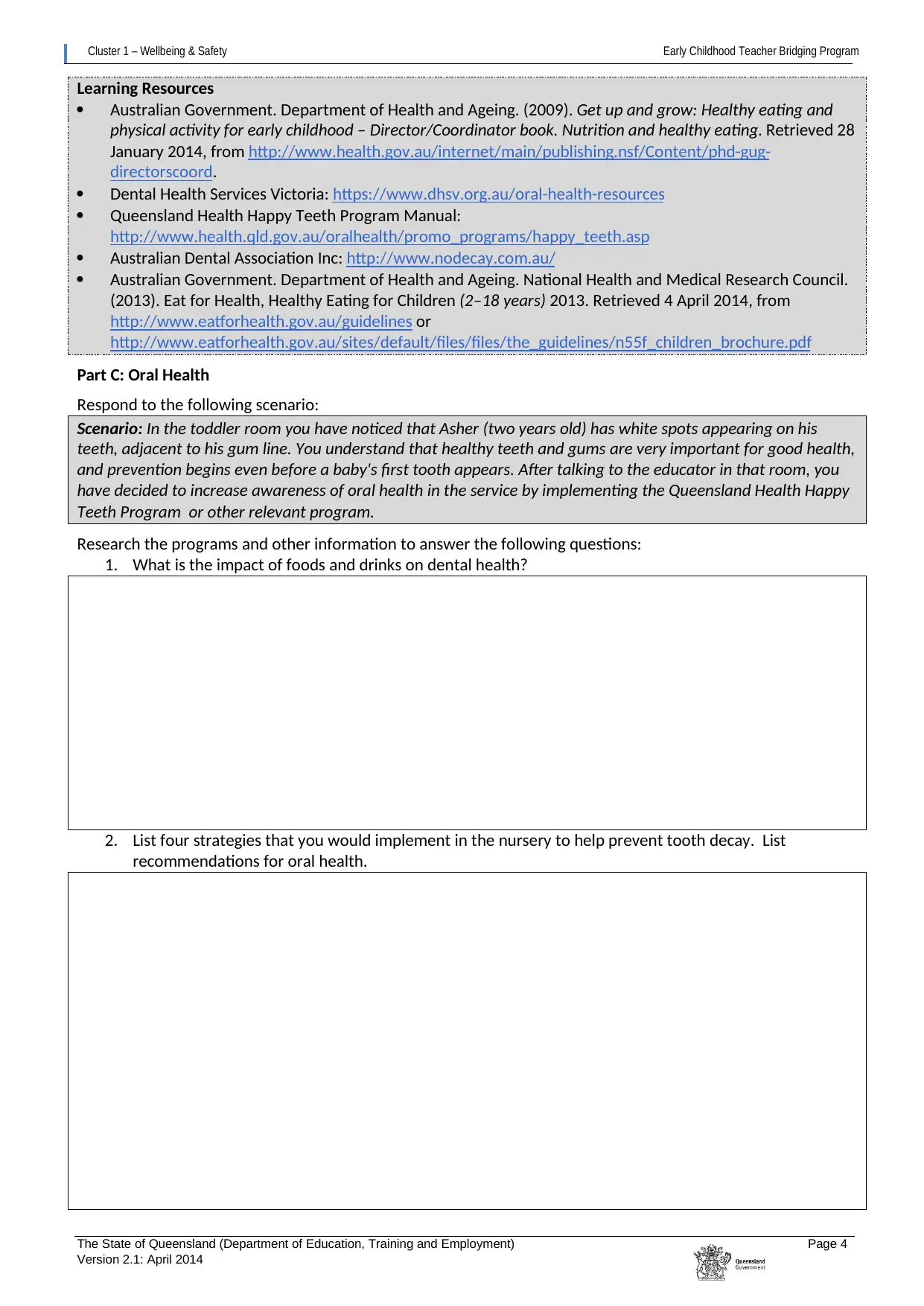
Cluster 1 – Wellbeing & Safety Early Childhood Teacher Bridging Program
The State of Queensland (Department of Education, Training and Employment) Page 4
Version 2.1: April 2014
Learning Resources
Australian Government. Department of Health and Ageing. (2009). Get up and grow: Healthy eating and
physical activity for early childhood – Director/Coordinator book. Nutrition and healthy eating. Retrieved 28
January 2014, from http://www.health.gov.au/internet/main/publishing.nsf/Content/phd-gug-
directorscoord.
Dental Health Services Victoria: https://www.dhsv.org.au/oral-health-resources
Queensland Health Happy Teeth Program Manual:
http://www.health.qld.gov.au/oralhealth/promo_programs/happy_teeth.asp
Australian Dental Association Inc: http://www.nodecay.com.au/
Australian Government. Department of Health and Ageing. National Health and Medical Research Council.
(2013). Eat for Health, Healthy Eating for Children (2–18 years) 2013. Retrieved 4 April 2014, from
http://www.eatforhealth.gov.au/guidelines or
http://www.eatforhealth.gov.au/sites/default/files/files/the_guidelines/n55f_children_brochure.pdf
Part C: Oral Health
Respond to the following scenario:
Scenario: In the toddler room you have noticed that Asher (two years old) has white spots appearing on his
teeth, adjacent to his gum line. You understand that healthy teeth and gums are very important for good health,
and prevention begins even before a baby's first tooth appears. After talking to the educator in that room, you
have decided to increase awareness of oral health in the service by implementing the Queensland Health Happy
Teeth Program or other relevant program.
Research the programs and other information to answer the following questions:
1. What is the impact of foods and drinks on dental health?
2. List four strategies that you would implement in the nursery to help prevent tooth decay. List
recommendations for oral health.
The State of Queensland (Department of Education, Training and Employment) Page 4
Version 2.1: April 2014
Learning Resources
Australian Government. Department of Health and Ageing. (2009). Get up and grow: Healthy eating and
physical activity for early childhood – Director/Coordinator book. Nutrition and healthy eating. Retrieved 28
January 2014, from http://www.health.gov.au/internet/main/publishing.nsf/Content/phd-gug-
directorscoord.
Dental Health Services Victoria: https://www.dhsv.org.au/oral-health-resources
Queensland Health Happy Teeth Program Manual:
http://www.health.qld.gov.au/oralhealth/promo_programs/happy_teeth.asp
Australian Dental Association Inc: http://www.nodecay.com.au/
Australian Government. Department of Health and Ageing. National Health and Medical Research Council.
(2013). Eat for Health, Healthy Eating for Children (2–18 years) 2013. Retrieved 4 April 2014, from
http://www.eatforhealth.gov.au/guidelines or
http://www.eatforhealth.gov.au/sites/default/files/files/the_guidelines/n55f_children_brochure.pdf
Part C: Oral Health
Respond to the following scenario:
Scenario: In the toddler room you have noticed that Asher (two years old) has white spots appearing on his
teeth, adjacent to his gum line. You understand that healthy teeth and gums are very important for good health,
and prevention begins even before a baby's first tooth appears. After talking to the educator in that room, you
have decided to increase awareness of oral health in the service by implementing the Queensland Health Happy
Teeth Program or other relevant program.
Research the programs and other information to answer the following questions:
1. What is the impact of foods and drinks on dental health?
2. List four strategies that you would implement in the nursery to help prevent tooth decay. List
recommendations for oral health.
⊘ This is a preview!⊘
Do you want full access?
Subscribe today to unlock all pages.

Trusted by 1+ million students worldwide
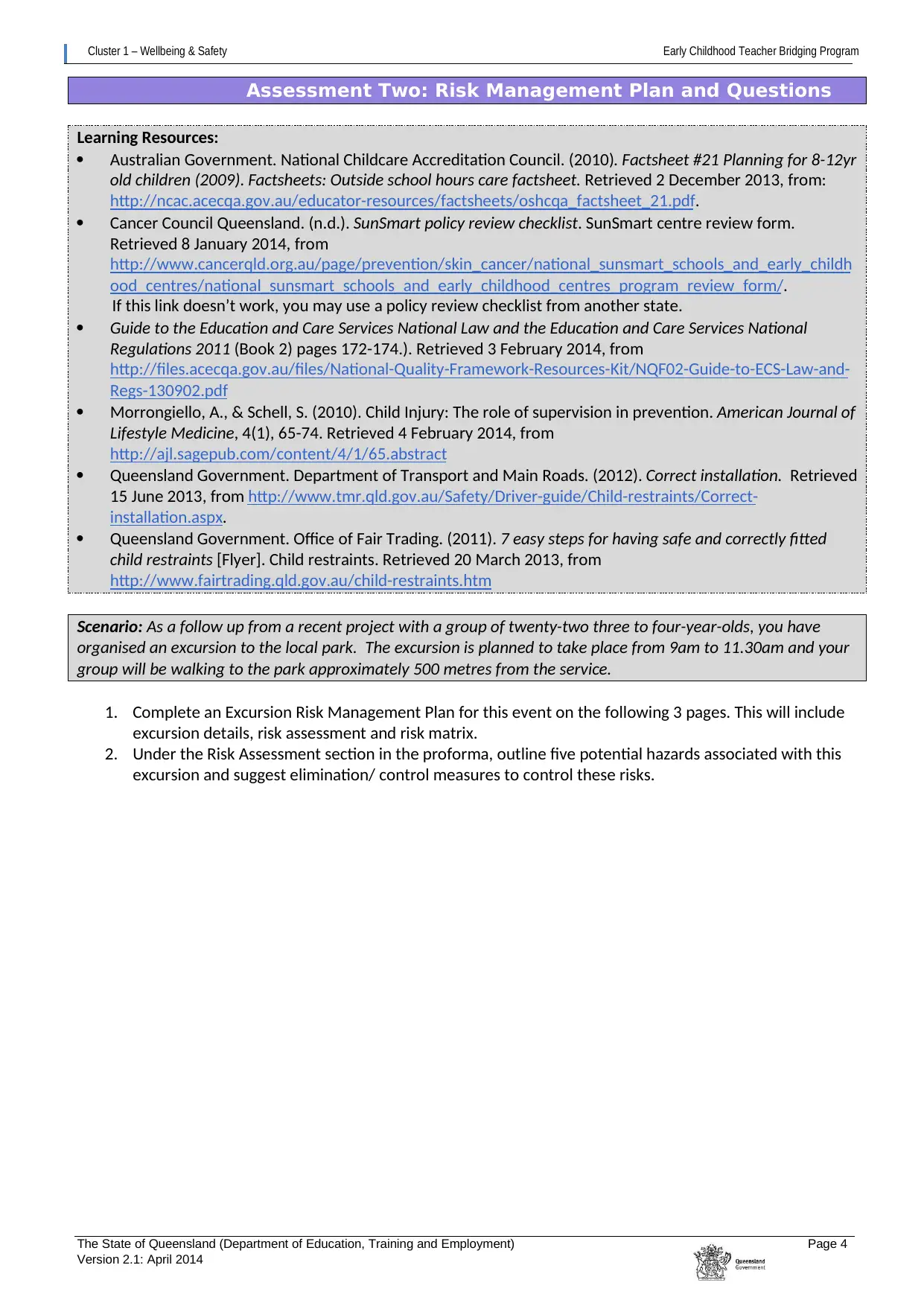
Cluster 1 – Wellbeing & Safety Early Childhood Teacher Bridging Program
The State of Queensland (Department of Education, Training and Employment) Page 4
Version 2.1: April 2014
Assessment Two: Risk Management Plan and Questions
Learning Resources:
Australian Government. National Childcare Accreditation Council. (2010). Factsheet #21 Planning for 8-12yr
old children (2009). Factsheets: Outside school hours care factsheet. Retrieved 2 December 2013, from:
http://ncac.acecqa.gov.au/educator-resources/factsheets/oshcqa_factsheet_21.pdf.
Cancer Council Queensland. (n.d.). SunSmart policy review checklist. SunSmart centre review form.
Retrieved 8 January 2014, from
http://www.cancerqld.org.au/page/prevention/skin_cancer/national_sunsmart_schools_and_early_childh
ood_centres/national_sunsmart_schools_and_early_childhood_centres_program_review_form/.
If this link doesn’t work, you may use a policy review checklist from another state.
Guide to the Education and Care Services National Law and the Education and Care Services National
Regulations 2011 (Book 2) pages 172-174.). Retrieved 3 February 2014, from
http://files.acecqa.gov.au/files/National-Quality-Framework-Resources-Kit/NQF02-Guide-to-ECS-Law-and-
Regs-130902.pdf
Morrongiello, A., & Schell, S. (2010). Child Injury: The role of supervision in prevention. American Journal of
Lifestyle Medicine, 4(1), 65-74. Retrieved 4 February 2014, from
http://ajl.sagepub.com/content/4/1/65.abstract
Queensland Government. Department of Transport and Main Roads. (2012). Correct installation. Retrieved
15 June 2013, from http://www.tmr.qld.gov.au/Safety/Driver-guide/Child-restraints/Correct-
installation.aspx.
Queensland Government. Office of Fair Trading. (2011). 7 easy steps for having safe and correctly fitted
child restraints [Flyer]. Child restraints. Retrieved 20 March 2013, from
http://www.fairtrading.qld.gov.au/child-restraints.htm
Scenario: As a follow up from a recent project with a group of twenty-two three to four-year-olds, you have
organised an excursion to the local park. The excursion is planned to take place from 9am to 11.30am and your
group will be walking to the park approximately 500 metres from the service.
1. Complete an Excursion Risk Management Plan for this event on the following 3 pages. This will include
excursion details, risk assessment and risk matrix.
2. Under the Risk Assessment section in the proforma, outline five potential hazards associated with this
excursion and suggest elimination/ control measures to control these risks.
The State of Queensland (Department of Education, Training and Employment) Page 4
Version 2.1: April 2014
Assessment Two: Risk Management Plan and Questions
Learning Resources:
Australian Government. National Childcare Accreditation Council. (2010). Factsheet #21 Planning for 8-12yr
old children (2009). Factsheets: Outside school hours care factsheet. Retrieved 2 December 2013, from:
http://ncac.acecqa.gov.au/educator-resources/factsheets/oshcqa_factsheet_21.pdf.
Cancer Council Queensland. (n.d.). SunSmart policy review checklist. SunSmart centre review form.
Retrieved 8 January 2014, from
http://www.cancerqld.org.au/page/prevention/skin_cancer/national_sunsmart_schools_and_early_childh
ood_centres/national_sunsmart_schools_and_early_childhood_centres_program_review_form/.
If this link doesn’t work, you may use a policy review checklist from another state.
Guide to the Education and Care Services National Law and the Education and Care Services National
Regulations 2011 (Book 2) pages 172-174.). Retrieved 3 February 2014, from
http://files.acecqa.gov.au/files/National-Quality-Framework-Resources-Kit/NQF02-Guide-to-ECS-Law-and-
Regs-130902.pdf
Morrongiello, A., & Schell, S. (2010). Child Injury: The role of supervision in prevention. American Journal of
Lifestyle Medicine, 4(1), 65-74. Retrieved 4 February 2014, from
http://ajl.sagepub.com/content/4/1/65.abstract
Queensland Government. Department of Transport and Main Roads. (2012). Correct installation. Retrieved
15 June 2013, from http://www.tmr.qld.gov.au/Safety/Driver-guide/Child-restraints/Correct-
installation.aspx.
Queensland Government. Office of Fair Trading. (2011). 7 easy steps for having safe and correctly fitted
child restraints [Flyer]. Child restraints. Retrieved 20 March 2013, from
http://www.fairtrading.qld.gov.au/child-restraints.htm
Scenario: As a follow up from a recent project with a group of twenty-two three to four-year-olds, you have
organised an excursion to the local park. The excursion is planned to take place from 9am to 11.30am and your
group will be walking to the park approximately 500 metres from the service.
1. Complete an Excursion Risk Management Plan for this event on the following 3 pages. This will include
excursion details, risk assessment and risk matrix.
2. Under the Risk Assessment section in the proforma, outline five potential hazards associated with this
excursion and suggest elimination/ control measures to control these risks.
Paraphrase This Document
Need a fresh take? Get an instant paraphrase of this document with our AI Paraphraser
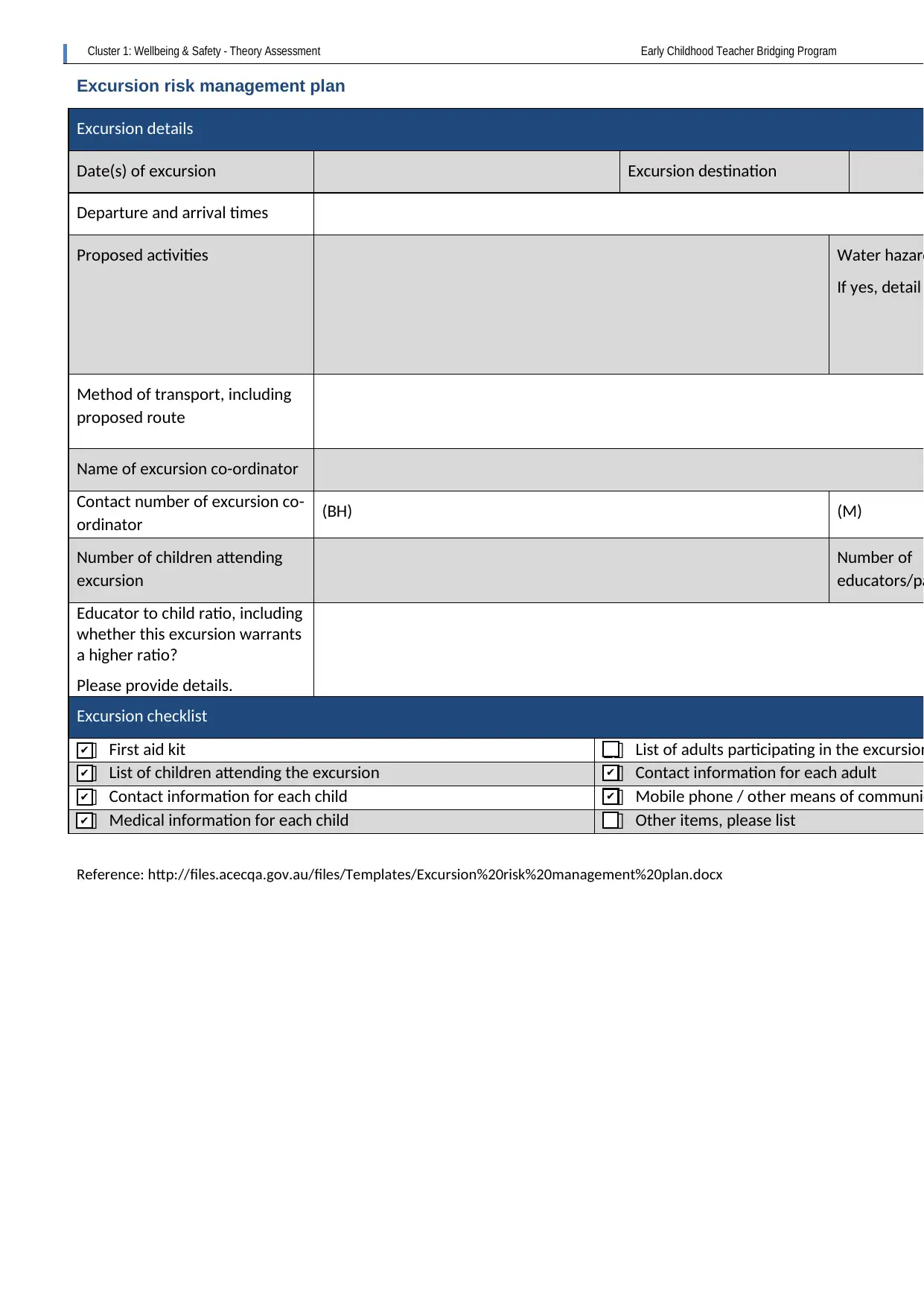
Cluster 1: Wellbeing & Safety - Theory Assessment Early Childhood Teacher Bridging Program
Reference: http://files.acecqa.gov.au/files/Templates/Excursion%20risk%20management%20plan.docx
Excursion risk management plan
Excursion details
Date(s) of excursion Excursion destination
Departure and arrival times
Proposed activities Water hazard
If yes, detail
Method of transport, including
proposed route
Name of excursion co-ordinator
Contact number of excursion co-
ordinator (BH) (M)
Number of children attending
excursion
Number of
educators/pa
Educator to child ratio, including
whether this excursion warrants
a higher ratio?
Please provide details.
Excursion checklist
First aid kit List of adults participating in the excursion
List of children attending the excursion Contact information for each adult
Contact information for each child Mobile phone / other means of communic
Medical information for each child Other items, please list
✔
✔
✔✔
✔
✔
Reference: http://files.acecqa.gov.au/files/Templates/Excursion%20risk%20management%20plan.docx
Excursion risk management plan
Excursion details
Date(s) of excursion Excursion destination
Departure and arrival times
Proposed activities Water hazard
If yes, detail
Method of transport, including
proposed route
Name of excursion co-ordinator
Contact number of excursion co-
ordinator (BH) (M)
Number of children attending
excursion
Number of
educators/pa
Educator to child ratio, including
whether this excursion warrants
a higher ratio?
Please provide details.
Excursion checklist
First aid kit List of adults participating in the excursion
List of children attending the excursion Contact information for each adult
Contact information for each child Mobile phone / other means of communic
Medical information for each child Other items, please list
✔
✔
✔✔
✔
✔
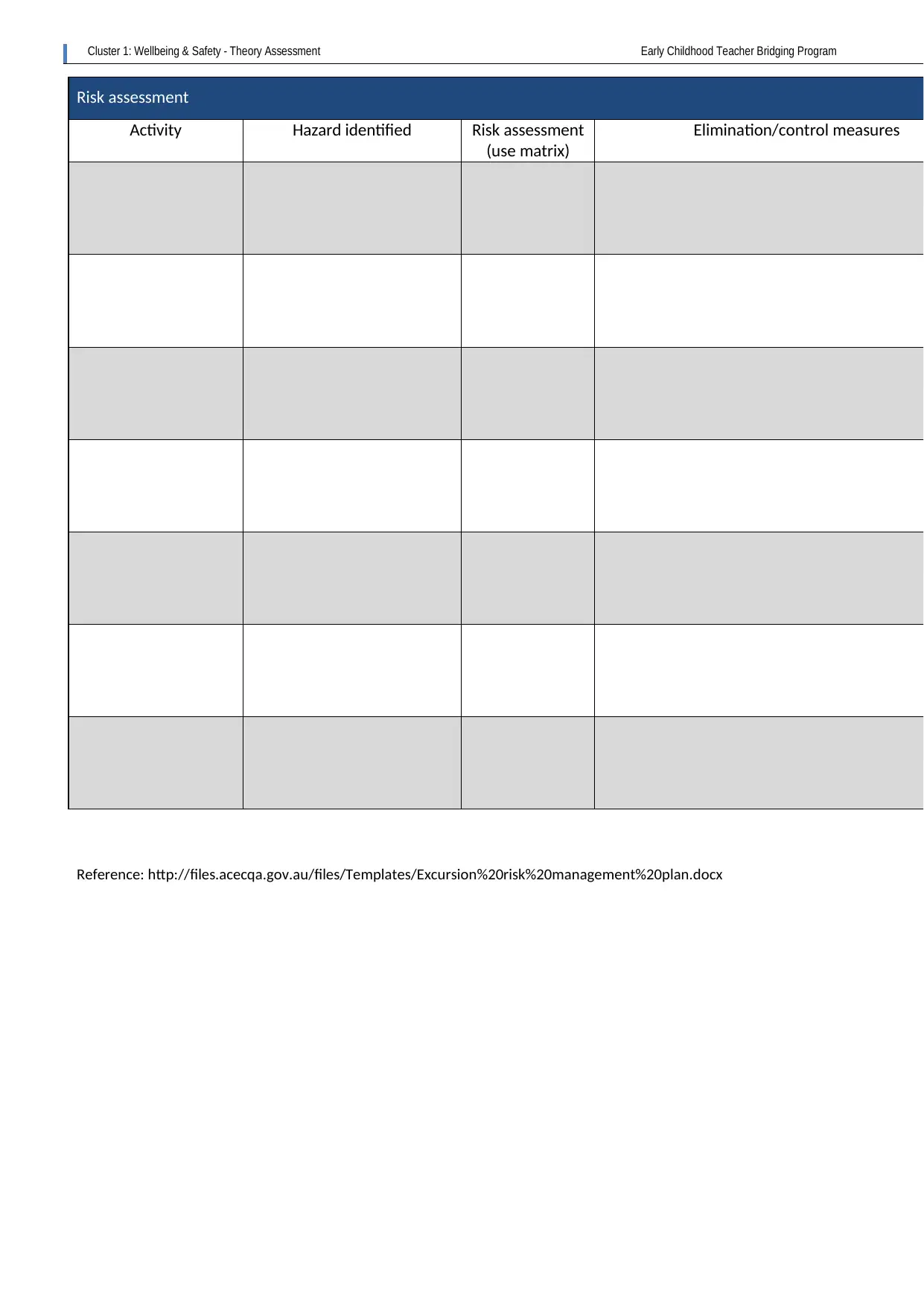
Cluster 1: Wellbeing & Safety - Theory Assessment Early Childhood Teacher Bridging Program
Reference: http://files.acecqa.gov.au/files/Templates/Excursion%20risk%20management%20plan.docx
Risk assessment
Activity Hazard identified Risk assessment
(use matrix)
Elimination/control measures
Reference: http://files.acecqa.gov.au/files/Templates/Excursion%20risk%20management%20plan.docx
Risk assessment
Activity Hazard identified Risk assessment
(use matrix)
Elimination/control measures
⊘ This is a preview!⊘
Do you want full access?
Subscribe today to unlock all pages.

Trusted by 1+ million students worldwide
1 out of 38
Related Documents
Your All-in-One AI-Powered Toolkit for Academic Success.
+13062052269
info@desklib.com
Available 24*7 on WhatsApp / Email
![[object Object]](/_next/static/media/star-bottom.7253800d.svg)
Unlock your academic potential
Copyright © 2020–2025 A2Z Services. All Rights Reserved. Developed and managed by ZUCOL.




